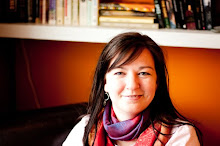In my studio over the past couple of days, we've been talking about an interesting system for organizing our palette. The Fletcher Palette system is based on the idea that colors and music are linked. It's a pretty complex system (for me at least) and I can't find a link online that explains it clearly, so I guess I'll attempt an explanation. Bear with me.
There are 12 musical notes and 12 colors that the palette is based on. The colors are all really intense chromatic colors, so forget about browns and beiges and grays for the time being. Think of a color wheel with Yellow, Yellow-Green, Green, Blue-Green, Blue, Blue-Violet, Violet, Red-Violet, Red, Red-Orange, Orange, and Yellow-Orange. You're also allowed to have White.
It looks a bit like this:
Ok, now in this example there are lines connecting complementary colors-- colors directly across from each other on the wheel-- like red and green, or purple and yellow, or orange and blue. The Fletcher System insists that these colors mixed together on a painting result in flat and muddy color. However, if you were to connect Orange to Blue-Green (instead of Blue) you would have a cleaner, crisper mixed color. So if you want to paint something that isn't so intensely chromatic, you would mix colors across the color wheel following a set pattern.
Here's where this relates to music. Fletcher's idea was that the 12 chromatic colors can be set up on a scale similar to the 12 tones in music. You then choose a color key for your painting, somewhat like choosing to play a song in the key of C. Once you've chosen your color key, then you mix your colors in intervals based on music as well. Another example: if you were to play a song in the key of C, then you'd play the notes C, E, and G to create a triad--or a major chord. The E note is third in the key and G is the fifth note in the key. (Chris had to explain this part to me last night.) So if you decide to paint using the key of Yellow, then following the circle around, you'd use Yellow, Red-Violet and Blue-Green which are spaced around the circle in intervals of three and five from Yellow. Look at the circle to figure this out. It's a little confusing.
You'd use those three colors mixed together to create a neutral gray, which you'd use similarly to a major chord in a song. It's the predominant harmony throughout the painting. And this system of arranging your palette allows you to have brighter and clearer colors in a painting.
As you can see, it's a bit complex. I'm intrigued by the idea that these intervals are so deeply ingrained that they can transfer from music to color, but there are a few holes in the theory for me. One, this only works with music based on the 12-note scale. Music in China, India and other parts of Asia, use a completely different scale, so I can't really buy in to the idea that this system has a universal appeal. Secondly, it's a bit frustrating and time consuming trying to mix a color that looks like Yellow Ochre when you have a tube Yellow Ochre right in your taboret.
Maybe the results are worth it. I'll let you know.
Thursday, May 15, 2008
Is Color linked to Music?
Subscribe to:
Post Comments (Atom)


No comments:
Post a Comment